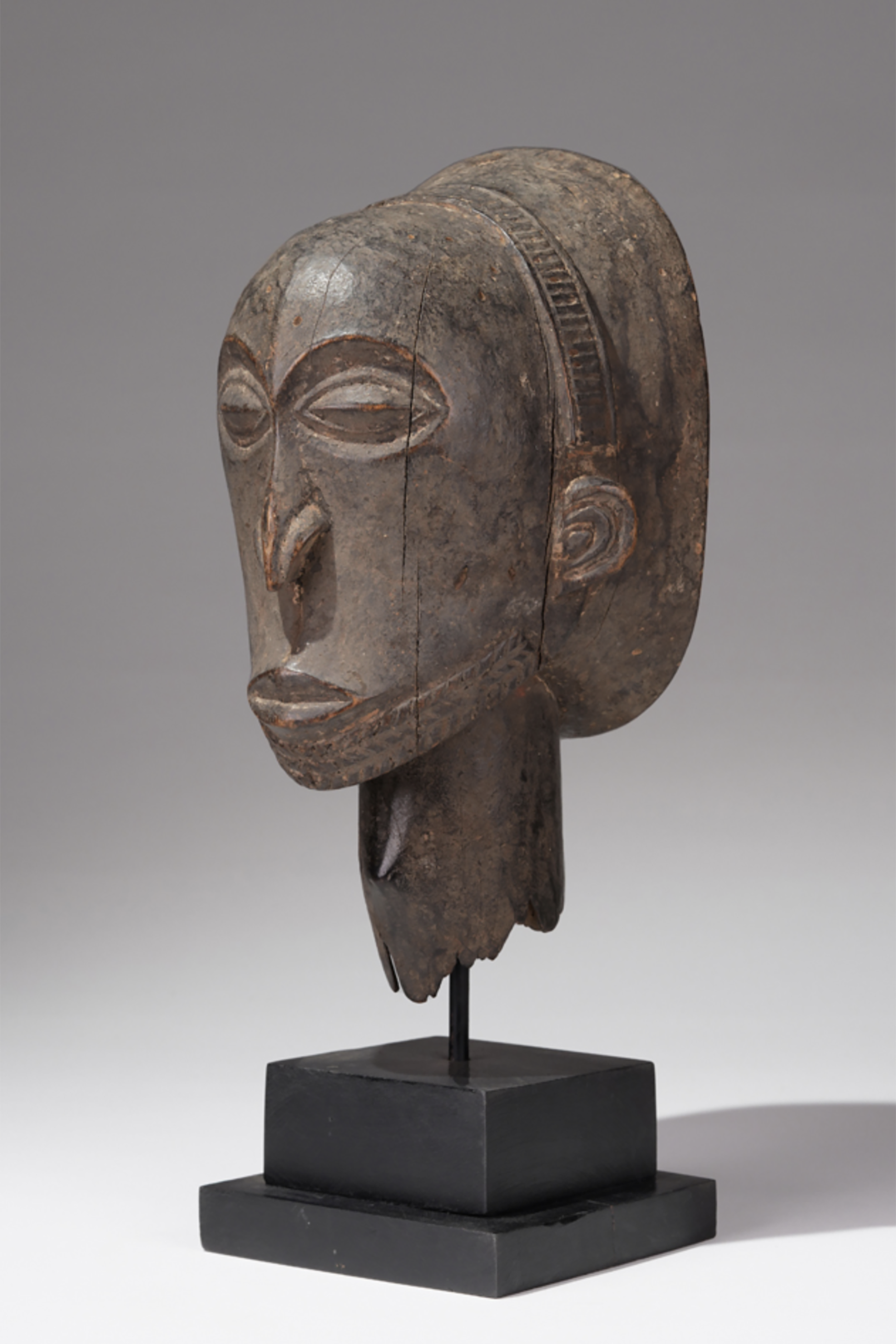wolfgang-jaenicke
A fragmented Hemba head
A fragmented Hemba head
Couldn't load pickup availability
A fragmented Hemba head, region Tanganyika, village Mbululam RDC, placed on a metal stand, oval shaped head, the mouth and the end of the jaw, a pointed nose, two almond shaped eyes, a small forehead, ears positioned at a lower angle, the hair is pulled back in the Hemba style; some cracks, traces of use, signs of use. Certificate of provenance.
“The traditional African Hemba art, from territories long banned for a long time, was little known in the West until its triumphant appearance through collections in the early 1970s. Among the Hemba, ancestor worship takes precedence over other values of society and this priority is sensitive in sculpture. The artists, often grouped in workshops, perform images of their ancestors. These figures are ritually present during clan ceremonies. This statuary quality is often highlighted by a beautiful patina. Primarily, the Hemba tribal art was related to the Luba style, but for some time it has been recognized for its own qualities as a distinct style.” Relics and effigy of ancestors, in CONGO River, Francois Neyt, Quais Branly Museum, p. 254-255
The Hemba people live around the Luika River in the southeastern part of the Democratic Republic of Congo in a territory between the Congo River and Lake Tanganyika. Historically, Hemba society was decentralized and segmented. Unlike the neighboring Luba, it did not have a central royal court. Each village was an autonomous entity where individuals identified with their own clan, which had a particular history of conquests, migrations, and alliances. The genealogy of each clan, which was well known going back eight, ten, or even fifteen generations, was essential to the chief to legitimate his claim of ownership over a specific territory. In the pre-colonial period, the general belief that no ancestors of a family group ever left their village of origin was a determining principle to the identity and authority of each Hemba clan. Upon death, important ancestors assumed benevolent powers and were meant to keep their descendants healthy, make women and soil fertile, and provide plenty of game. The founder of the clan was considered a particularly powerful and sacred ancestor. Each chief assumed his responsibilities based on his genealogical link with this individual, and only his direct descendants were eligible to succeed him.
Heroes Enshrined: Hemba Art
Through sculpted wooden statues (singiti, pl. lusingiti) designed to shelter the spirits of the clan’s ancestors the Hemba could maintain a direct and lasting engagement with them. Designated structures were erected in each village to preserve these statues. In these ancestral mausoleums, petitions were made to them, and they were frequently coated with palm oil, cassava flour and chicken blood. According to the Hemba scholar François Neyt, each important family generally possessed three or four ancient statues which preserved the memory of the genealogy. They served as a tangible evidence of a chief’s ties with a territory and the validation of the legitimacy of his authority. Neyt therefore called them "genealogical milestones" (La Grande Statuaire Hemba du Zaire, 1977, p. 489), perpetuating the memory of the great personalities they honored. Each singiti was associated with oral traditions that linked the statue to the history of a family. Through these exemplary life stories, these statues served as ambitious examples of the role of a leader. In the precolonial era, these commemorative statues, placed at the political and spiritual epicenter of all Hemba communities, were collectively invoked to intervene for the well-being of the villagers. The presence of singiti was essential to the establishment of a sense of unity and social cohesion in the village. These statues performed as physical proof of the reciprocity of the world of the living and the dead in a relationship of dependence and belonging.
Source: A Hemba Masterpiece by Bruno Claessen, By Christies.
Enquire.
Height: 50 cm incl. stand
Weight: 4,5 kg incl. stand
Hemba sculptures, particularly the singiti (ancestor figures), are renowned for their serene and introspective expressions, reflecting the community's emphasis on lineage, authority, and ancestral veneration. The figures often feature elongated faces, elaborate coiffures, and detailed beards, symbolizing the idealized traits of past leaders. These artworks were not merely decorative but served as conduits for communication between the living and the ancestral realm. The Niembo de la Luika workshops, located in the heart of the Hemba region, are particularly noted for producing these masterpieces .Collection Marc Ladreit de Lacharrire
Historical Context and Colonial Impact
The region of Tanganyika, now part of modern-day Tanzania, was under German colonial rule from 1884 to 1918 and later became a British mandate until its independence in 1961. During these periods, numerous cultural artifacts were removed from the region and are now housed in various European museums. For instance, the Ethnologisches Museum in Berlin holds over 10,000 objects from present-day Tanzania, many of which are from the Hemba and other ethnic groups .Wikipedia
Museum Collections and Exhibitions
In Berlin, the Humboldt Forum's "Histories of Tanzania" exhibition critically examines the colonial era and its impact on the region's cultural heritage. The exhibition presents over 10,000 objects from Tanzania, including Hemba artifacts, and offers multiple narratives to challenge colonial perspectives.
Internationally, institutions like the Art Institute of Chicago and the Metropolitan Museum of Art in New York house Hemba sculptures. For example, the Art Institute's "Ritual Head" is a mid-19th-century piece characterized by its elongated face and intricate coiffure, reflecting the Hemba's artistic traditions . Similarly, the Met's "Commemorative Portrait of a Chief" showcases the Hemba's ability to convey tranquility and nobility through their carvings.
Conclusion
A fragmented Hemba head from the Tanganyika region would not only be a valuable piece of art but also a poignant reminder of the region's rich cultural heritage and the enduring legacy of its people. Such an artifact would offer a tangible connection to the past, providing insights into the spiritual and artistic practices that defined the Hemba community. Source Chat GPT.

























